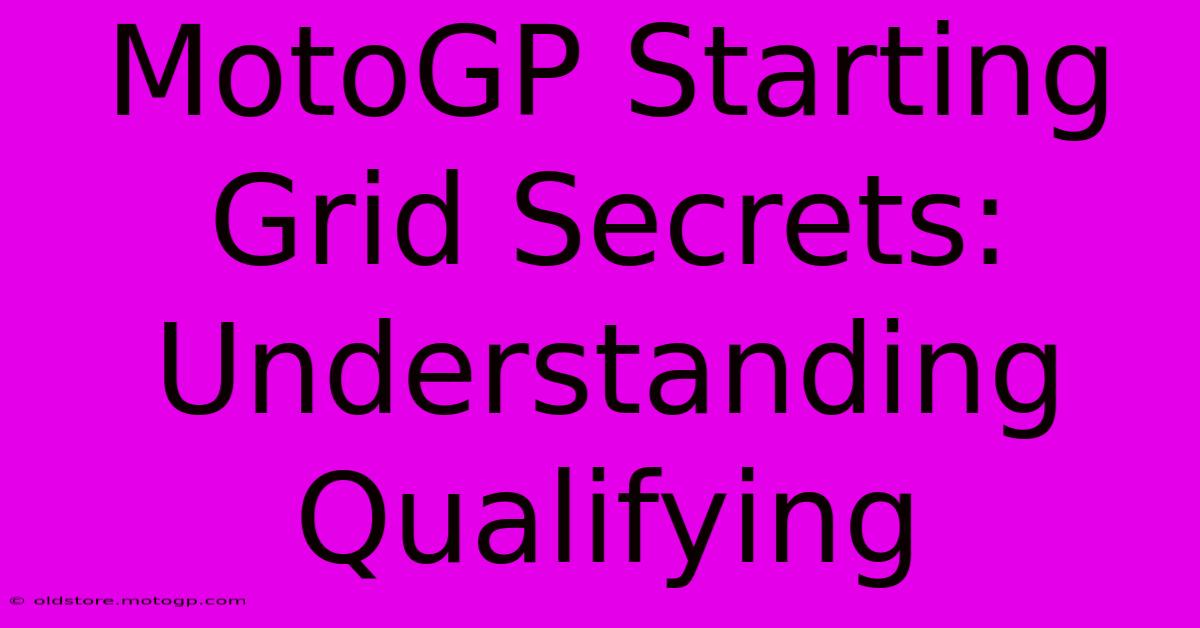MotoGP Starting Grid Secrets: Understanding Qualifying

Table of Contents
MotoGP Starting Grid Secrets: Understanding Qualifying
MotoGP, the pinnacle of motorcycle racing, is a spectacle of speed, skill, and strategy. But before the lights go out and the bikes roar into action, there's a crucial phase that determines much of the race's outcome: qualifying. Understanding the intricacies of MotoGP qualifying is key to appreciating the drama and predicting the race results. This article delves into the secrets behind the starting grid, explaining the process and highlighting the factors that contribute to a rider's qualifying performance.
The Qualifying Format: A Breakdown
MotoGP qualifying isn't a simple time trial. It's a multi-stage process designed to separate the fastest riders from the rest, adding tension and excitement for viewers. The current format typically involves:
Q1 (Qualifying 1):
- Participants: Riders who haven't finished within the top 10 in the combined Free Practice sessions (FP1, FP2, and FP3). This means the slower riders and those who might have experienced setbacks earlier in the weekend are here.
- Time Allotment: A set time limit, usually around 15 minutes, to complete as many laps as possible.
- Outcome: The two fastest riders from Q1 automatically progress to Q2.
Q2 (Qualifying 2):
- Participants: The top 10 riders from the combined Free Practice sessions, plus the two fastest from Q1. This is where the championship contenders and top performers battle it out.
- Time Allotment: Similar to Q1, a set time limit of around 15 minutes.
- Outcome: The grid positions from 1st to 12th are determined by the fastest lap times achieved in Q2.
Key Factors Affecting Qualifying Performance
Several factors contribute to a rider's success during qualifying:
1. Bike Setup:
The motorcycle's setup is paramount. A bike perfectly tailored for qualifying might not be ideal for the race, requiring a balance between speed and race pace. This involves meticulous adjustments to suspension, aerodynamics, and engine settings. Even small changes can drastically impact lap times.
2. Tire Choice:
Tire selection is a crucial strategic element. Qualifying laps demand maximum grip, often utilizing softer, less durable tires that wear out quickly. Riders must judge the track conditions and choose the tires that offer the optimal balance of grip and consistency for their qualifying run. The weather is a key variable.
3. Track Conditions:
The track itself plays a significant role. Temperature, grip levels, and even the presence of wind can dramatically affect lap times. Riders and teams constantly monitor these conditions and adjust their strategies accordingly.
4. Rider Skill and Confidence:
Ultimately, rider skill and confidence are essential. Pushing a MotoGP machine to its absolute limit requires immense skill and nerves of steel. A rider's ability to execute a perfect lap, consistently maintaining optimal lines and speed, will separate the contenders.
5. Slipstream (Drafting):
MotoGP bikes are highly susceptible to slipstreaming. Following closely behind another bike reduces aerodynamic drag, enabling significant speed gains. Clever use of slipstreaming can provide a crucial advantage, especially in the final moments of qualifying. Finding a good tow can gain several tenths of a second, a huge difference in the tightly contested MotoGP grid.
Beyond the Time: Strategy and Psychology
Qualifying isn't just about pure speed. It’s also about strategic thinking and understanding the limitations of the equipment. Riders and teams might decide to prioritize a consistently fast race pace over achieving the absolute fastest lap time in qualifying if they foresee better race pace as a winning factor.
The psychological aspect cannot be overlooked. The pressure of qualifying under a time limit, knowing that a small mistake can have massive consequences, demands mental fortitude. The tension is palpable, and nerves can play a decisive role in determining the outcome.
Conclusion: A Critical Stage in MotoGP
MotoGP qualifying isn't merely a prelude to the race; it's a high-stakes competition in its own right. Understanding the intricacies of the qualifying format, the factors influencing performance, and the strategic and psychological elements reveals a layer of depth and complexity often overlooked by casual viewers. By understanding these secrets, you can gain a far deeper appreciation for the battles fought on the track before the race even begins. The starting grid isn't simply random – it's the product of meticulous preparation, precision, and the culmination of skill and strategy.

Thank you for visiting our website wich cover about MotoGP Starting Grid Secrets: Understanding Qualifying. We hope the information provided has been useful to you. Feel free to contact us if you have any questions or need further assistance. See you next time and dont miss to bookmark.
Featured Posts
-
Cota The Ultimate F1 Qualifying Experience
Feb 24, 2025
-
Yamaha Moto Gp Team News Celebrating Moto Gp Victories
Feb 24, 2025
-
Hear The Roar F1 Austin Concert Spectacle
Feb 24, 2025
-
F1 Strategy Simplified Understanding Grid Formula 1
Feb 24, 2025
-
Moto Gp Arcade Thrills At Your Fingertips
Feb 24, 2025
